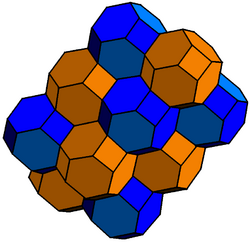Bitruncation

In geometry, a bitruncation is an operation on regular polytopes. It represents a truncation beyond rectification.[citation needed] The original edges are lost completely and the original faces remain as smaller copies of themselves.
Bitruncated regular polytopes can be represented by an extended Schläfli symbol notation t1,2{p,q,...} or 2t{p,q,...}.
In regular polyhedra and tilings
For regular polyhedra (i.e. regular 3-polytopes), a bitruncated form is the truncated dual. For example, a bitruncated cube is a truncated octahedron.
In regular 4-polytopes and honeycombs
For a regular 4-polytope, a bitruncated form is a dual-symmetric operator. A bitruncated 4-polytope is the same as the bitruncated dual, and will have double the symmetry if the original 4-polytope is self-dual.
A regular polytope (or honeycomb) {p, q, r} will have its {p, q} cells bitruncated into truncated {q, p} cells, and the vertices are replaced by truncated {q, r} cells.
Self-dual {p,q,p} 4-polytope/honeycombs
An interesting result of this operation is that self-dual 4-polytope {p,q,p} (and honeycombs) remain cell-transitive after bitruncation. There are 5 such forms corresponding to the five truncated regular polyhedra: t{q,p}. Two are honeycombs on the 3-sphere, one a honeycomb in Euclidean 3-space, and two are honeycombs in hyperbolic 3-space.
| Space | 4-polytope or honeycomb | Schläfli symbol Coxeter-Dynkin diagram |
Cell type | Cell image |
Vertex figure |
|---|---|---|---|---|---|
| [math]\displaystyle{ \mathbb{S}^3 }[/math] | Bitruncated 5-cell (10-cell) (Uniform 4-polytope) |
t1,2{3,3,3} |
truncated tetrahedron | 
|

|
| Bitruncated 24-cell (48-cell) (Uniform 4-polytope) |
t1,2{3,4,3} |
truncated cube | 
|

| |
| [math]\displaystyle{ \mathbb{E}^3 }[/math] | Bitruncated cubic honeycomb (Uniform Euclidean convex honeycomb) |
t1,2{4,3,4} |
truncated octahedron | 
|

|
| [math]\displaystyle{ \mathbb{H}^3 }[/math] | Bitruncated icosahedral honeycomb (Uniform hyperbolic convex honeycomb) |
t1,2{3,5,3} |
truncated dodecahedron | 
|

|
| Bitruncated order-5 dodecahedral honeycomb (Uniform hyperbolic convex honeycomb) |
t1,2{5,3,5} |
truncated icosahedron | 
|

|
See also
- uniform polyhedron
- uniform 4-polytope
- Rectification (geometry)
- Truncation (geometry)
References
- Coxeter, H.S.M. Regular Polytopes, (3rd edition, 1973), Dover edition, ISBN:0-486-61480-8 (pp. 145–154 Chapter 8: Truncation)
- Norman Johnson Uniform Polytopes, Manuscript (1991)
- N.W. Johnson: The Theory of Uniform Polytopes and Honeycombs, Ph.D. Dissertation, University of Toronto, 1966
- John H. Conway, Heidi Burgiel, Chaim Goodman-Strauss, The Symmetries of Things 2008, ISBN:978-1-56881-220-5 (Chapter 26)
External links
 |


